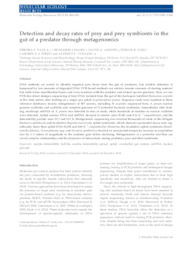Detection and decay rates of prey and prey symbionts in the gut of a predator through metagenomics.
Detection and decay rates of prey and prey symbionts in the gut of a predator through metagenomics.
Author(s): PAULA, D. P.; LINARD, B.; ANDOW, D. A.; SUJII, E. R.; PIRES, C. S. S.; VOGLER, A. P.
Summary: DNA methods are useful to identify ingested prey items from the gut of predators, but reliable detection is hampered by low amounts of degraded DNA. PCR-based methods can retrieve minute amounts of starting material but suffer from amplification biases and cross-reactions with the predator and related species genomes. Here, we use PCR-free direct shotgun sequencing of total DNA isolated from the gut of the harlequin ladybird Harmonia axyridis at five time points after feeding on a single pea aphid Acyrthosiphon pisum. Sequence reads were matched to three reference databases: Insecta mitogenomes of 587 species, including H. axyridis sequenced here; A. pisum nuclear genome scaffolds; and scaffolds and complete genomes of 13 potential bacterial symbionts. Immediately after feeding, multicopy mtDNA of A. pisum was detected in tens of reads, while hundreds of matches to nuclear scaffolds were detected. Aphid nuclear DNA and mtDNA decayed at similar rates (0.281 and 0.11 h1 respectively), and the detectability periods were 32.7 and 23.1 h. Metagenomic sequencing also revealed thousands of reads of the obligate Buchnera aphidicola and facultative Regiella insecticola aphid symbionts, which showed exponential decay rates significantly faster than aphid DNA (0.694 and 0.80 h 1, respectively). However, the facultative aphid symbionts Hamiltonella defensa, Arsenophonus spp. and Serratia symbiotica showed an unexpected temporary increase in population size by 1?2 orders of magnitude in the predator guts before declining. Metagenomics is a powerful tool that can reveal complex relationships and the dynamics of interactions among predators, prey and their symbionts.
Publication year: 2015
Types of publication: Journal article
Keywords: Analyte detectability half-life, Coccinellid, Pulgão
Observation
Some of Embrapa's publications are published as ePub files. To read them, use or download one of the following free software options to your computer or mobile device. Android: Google Play Books; IOS: iBooks; Windows and Linux: Calibre.
Access other publications
Access the Agricultural Research Database (BDPA) to consult Embrapa's full library collection and records.
Visit Embrapa Bookstore to purchase books and other publications sold by Embrapa.

